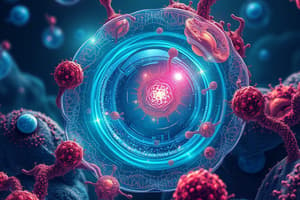Podcast
Questions and Answers
Why is a high surface area-to-volume ratio important for cells?
Why is a high surface area-to-volume ratio important for cells?
- It facilitates efficient exchange of materials like oxygen, nutrients, and waste. (correct)
- It protects the cell from external physical damage.
- It allows the cell to maintain a lower internal temperature.
- It enhances the cell's ability to store genetic information.
As a cell increases in size, what happens to its surface area-to-volume ratio?
As a cell increases in size, what happens to its surface area-to-volume ratio?
- The surface area-to-volume ratio decreases. (correct)
- The surface area-to-volume ratio remains constant.
- The surface area-to-volume ratio increases linearly.
- The surface area-to-volume ratio increases exponentially.
How does a smaller cell size benefit its function compared to a larger cell size?
How does a smaller cell size benefit its function compared to a larger cell size?
- Smaller cells can exchange materials more efficiently due to a higher surface area-to-volume ratio. (correct)
- Smaller cells are more resistant to viral infections.
- Smaller cells have a greater capacity for storing waste products.
- Smaller cells have a lower metabolic rate, conserving energy.
Which of the following best describes a cell with a low surface area-to-volume ratio?
Which of the following best describes a cell with a low surface area-to-volume ratio?
A scientist is studying two cells: Cell A has a surface area of $150 \mu m^2$ and a volume of $50 \mu m^3$, while Cell B has a surface area of $200 \mu m^2$ and a volume of $100 \mu m^3$. Which cell is more efficient in exchanging substances with its environment?
A scientist is studying two cells: Cell A has a surface area of $150 \mu m^2$ and a volume of $50 \mu m^3$, while Cell B has a surface area of $200 \mu m^2$ and a volume of $100 \mu m^3$. Which cell is more efficient in exchanging substances with its environment?
How does a cell's shape relate to its function as its size increases?
How does a cell's shape relate to its function as its size increases?
Why is maintaining a high surface area-to-volume ratio crucial for optimal cell function?
Why is maintaining a high surface area-to-volume ratio crucial for optimal cell function?
Which cellular process is most directly affected by the surface area-to-volume ratio?
Which cellular process is most directly affected by the surface area-to-volume ratio?
Within a multicellular organism, what challenge do larger cells face compared to smaller cells, based on surface area-to-volume ratio?
Within a multicellular organism, what challenge do larger cells face compared to smaller cells, based on surface area-to-volume ratio?
How does the relationship between a cell's surface area and volume affect its ability to sustain metabolic activity?
How does the relationship between a cell's surface area and volume affect its ability to sustain metabolic activity?
Flashcards
Surface Area (SA)
Surface Area (SA)
The outer part of a cell that allows material exchange.
Volume (V)
Volume (V)
The inside of the cell containing organelles and materials.
SA:V ratio
SA:V ratio
The comparison of surface area to volume in a cell.
Effects of Cell Size
Effects of Cell Size
Signup and view all the flashcards
Importance of High SA:V ratio
Importance of High SA:V ratio
Signup and view all the flashcards
Adapted Cell Shape
Adapted Cell Shape
Signup and view all the flashcards
Larger Cells Challenges
Larger Cells Challenges
Signup and view all the flashcards
Smaller Cells Advantages
Smaller Cells Advantages
Signup and view all the flashcards
Nutrient and Waste Movement
Nutrient and Waste Movement
Signup and view all the flashcards
Cell Size and Efficiency
Cell Size and Efficiency
Signup and view all the flashcards
Study Notes
Surface Area to Volume Ratio (SA:V)
- Cell size impacts its ability to perform essential functions, including material exchange.
- Larger cells face challenges in efficient material exchange due to slower exchange rates compared to the increased volume.
- Surface area (SA) is the outer part of a cell; larger SA facilitates more material entry and exit.
- Volume (V) is the cell's interior; larger V requires more resources and waste removal.
- As a cell grows, volume increases at a faster rate than surface area, thus decreasing the SA:V ratio.
- A cell's shape and size are critical factors impacting its ability to efficiently perform functions.
Small Cells
- Small cells have a higher SA:V ratio.
- The higher ratio allows for easier and efficient exchange of materials (oxygen, nutrients, waste).
- Analogy: a small room with ample windows.
Large Cells
- Large cells have a lower SA:V ratio.
- The lower ratio makes efficient material exchange challenging.
- Analogy: a large room with small windows.
Cell Size and Efficiency
- Cells require a high SA:V ratio for efficient movement of oxygen, nutrients, and waste removal.
- This is a crucial reason why cells are typically small.
- Adaptations in cell shape can improve the SA:V ratio and allow larger cells to function efficiently.
Studying That Suits You
Use AI to generate personalized quizzes and flashcards to suit your learning preferences.




